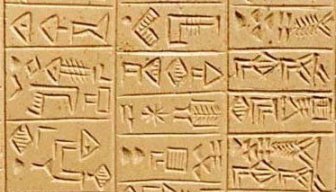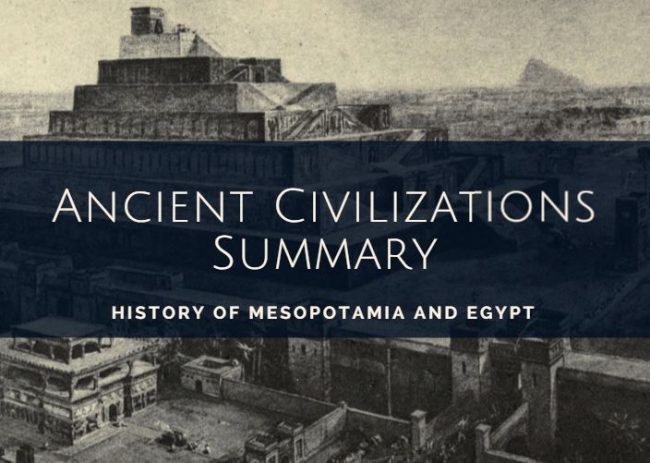WHAT AM I GOING TO LEARN?
1. Early writings.
2. Egypt: natural environment, historical evolution, economy, politics, society, religion and art
WHAT DO I HAVE TO STUDY?
●Unit from your book.
● English handouts and worksheets.
● Spanish and English vocabulary (use your glossary book and vocabulary organizer)
●Activities from your book.
● The outline you made.

How and where did cities appear? Why did people start writing:
Writing appeared in Mesopotamia over 5,000 years ago. When people lived in villages, the population group was smaller and it was easier to memorise their names, who herds belonged to, the size and amount of the crops, etc. But when cities grew, it became necessary to control and keep the datawhich interested the king and his government: taxes, trade transactions, contracts, wills,etc.

The first civilizations:


It was about 5000 years ago that the first civilizations apperared along the banks of large rivers. That is why they are called river civilizations. In Mesopotamia, Egypt, India and China they emerged along rivers: the Tigris and the Euphrates, in Mesopotamia the River Nile, in Egypt; the Indus River in India; and the Yellow and Blue rivers, in China
Lifestyle and the way society was structured in the river civilizations were completely different from the ones before. If we compare them, we can observe a great change.


The main characteristics of river civilizations were:

Their strong political power. The king kept control of everything, from politics to religion. He passed laws to rule his country. The king was also in charge of the army which he created to protect his possessions.and many times the king had religious functions. There were also civil servants who helped the king to manage his possessions.
Society was very hierarchical. The population was divided into two very different groups: few of them were privileged people and the majority were subjugated people. Most of the lands and riches belonged to the first ones, the privileged people.

Also, they were in charge of the main public offices.
Their great artistic development. Through art kings magnified their power so they encouraged all kinds of art
SOCIETY
The first civilizations:
From the year 3000 BC , cities grew enormously and their population consisted of thousands of people. Life in these cities became more complex and it was necessary to make a division of work. Each person was dedicated to a specific job and got all his other needs at the market. People lived in a different quarters of the city depending on how rich they were and what their job was.
Cities were not self-sufficient , not all the necessitites could be obtained there and people had to buy some food, raw materials and luxury products in far away regions. That is why trade had a great importance. The river civilizations did not have coins so they used barter, which means interchanging products.
SOCIETY: The pharaoh In Egypt the king was called pharaoh. The pharaoh concentrated all the power. Most of the lands belonged to him. He supervised trade and led the armies, he passed laws and reigned over the country.
For the Egyptians the pharaoh was a god. They couldn´t touch him or look him in the eye. They knelt when he passed them by. Since they thought the pharaoh was a divinity, they believed in his magical powers. For example, they thought that when there was a drought, he could make the waters of the Nile rise.
When a pharaoh died, his son replaced him, forming a dynasty. There were thirty dynasties in the history of Egypt.
Noblemen and priests
Noblemen and priests were in charge of the most important posts in Egypt
The noblemen were members of the pharaoh´s family. Also, when the pharaoh wanted to reward somebody he gave him large amounts of land and great treasures and made them noblemen.
The priests led the religious rites. They owned many pieces of land and herds. They were very wealthy and had thousands of servants.
Other important posts in the Egyptian state and society were:
1. The vizier was a primer minister who helped the pharaoh to govern the country.
2. The scribes were the only people in Egypt who could read, write and count. This is why they had good reputation and a good economic situation. The priests and some noblemen could also read and write. The scribes were in charge of writing official documents and keeping account of the royal taxes and the goods that went in and out of the pharaoh´s palace.
Peasants
Nine out of ten Egyptian men and women were peasants. They were very poor and lived in small mud-brick houses along the River Nile.
It was very difficult for peasants to survive. They had a very difficult life. The pharaoh, the priests and the noblemen owned the lands and the peasants cultivated them. In exchange for their work, they could have a part of the harvest, but they had to give another part to the landowners and they had to pay a sum to the pharaoh as a tax.
All the family participated in the different farming tasks : the men ploughed and the women sowed; both did the harvesting. The children helped their parents since they were very young.
Their work was very hard. Most agricultural tools that they used were similar to those of earlier times: for example, the sickles and the hoes were made of stone, wood or bronze. But they used a new tool which made their lives easier: the plough. With the plough it was not necessary for peasants to bend their backs to cultivate the land. They could also make deeper furrows.
During the season of the Nile floods, peasants were recruited by the pharaoh to participate in the construction of pyramids and other public buildings.
Other professions in Egyptian civilization were: sailors, soldiers, craftsmen and merchants.
Sailors travelled by ship to far away lands to buy wood, metals and perfumes.
Soldiers fought in wars and, in exchange, the pharaoh gave them with lands, gold and slaves.
The majority of the craftsmen worked for the pharaoh. The most important were: stone carvers, sculptors, goldsmiths and papyrus and linen* manufacturers.
Merchants sold products. Since money did not exist in Egypt at that time, they used barter. Barter means that they exchanged some products for others.Slaves
They were usually war prisoners and had no rights. Most of them were owned by the pharaoh, although priests and noblemen had slaves too. The pharaoh used them for building great monuments, working in copper mines or as soldiers.

FROM CITIES TO EMPIRES
During the Metal Age, small cities were governed by kings. Later, the kings unified territories and cities which were nearby in order to extend their possessions and to get greater power. Some other times, they made war to enlarge their territories. This way kings became very powerful and succeeded in forming large empires.
As kings expanded their territories, they needed to create a state structure that assured their dominance and power. To do this, they designated governors and created bodies of civil servants. The governors held administrative and military functions in the farthest provinces, and the civil servants, who could write, read and count, were in charge of collecting taxes. In different places, civil servants were called different names; for example, mandarins in China, and scribes in Mesopotamia and Egypt.
The relations between the inhabitants became more complicated and to regulate them the first codes of law were created. One example is the code of Hammurabi in Mesopotamia. The need for other legal documents also increased, such as contracts, receipts, judgements, wills, etc.
EGYPT:
Its territory was located along the course of the River Nile and it was divided into two small kingdoms called Upper Egypt and Lower Egypt. Upper Egypt was situated in a narrow valley along which the River Nile runs. Lower Egypt is the area a little before the river empties into the Mediterranean sea by forming a wide delta.
Around the year 3100 BC, King Menna united both kingdoms, called Lower and Upper Egypt, and this way he became the first Egyptian pharaoh.
Egyptian history is divided into three long periods.
From 3100 to 2200 BC: The Old Empire. During this period, the pharaohs Khufu, Khafra and Menkaura ordered the construction of great pyramids.
From 2100 to 1800 BC: The Middle Empire. During this period the pharaohs conquered lands in Nubia, to the south of Egypt.
From 1600 to 1100 BC: The New Empire. During this period, the pharaohs Thutmose I and Rameses I were important because they conquered Palestine and Syria, extending their territories through the East.
In the last years of its history, the Persians and the Greek dominated Egypt. Finally they were conquered by the Romans in the 1st century BC.
EGYPTIAN ART AND RELIGION
The Egyptians were polytheistic. The main god was the sun, called in different ways: Ra, Amun or Atum. Other gods were Isis, Osiris and Horus. The Egyptians also worshipped natural elements (earth, river Nile), animals (crocodile), and the pharaoh.
Religious rites were carried out in the temples. Rites were necessary to preserve the order of the universe. There were priests for each god and a great temple was built to keep the statue of the god where he could be worshipped. Temples had colossal dimensions and they were decorated with enormous columns. The most famous temples are those of Karnak and Luxor, both inThebes, and that of Abu Simbel, in the south of the country.
The Egyptians believed in life after death and wanted to keep the bodies for the new life. Dead people were converted into mummies, that is, corpses were dried and wrapped with bandages. Mummies were put into a sarcophagus and buried in tombs.
The sarcophagus was surrounded by different things that the deceased could need in their life after death: food, clothing, servant statutes, this was a treasure.


THE PYRAMIDS
The first pharaohs were buried in enormous stone pyramids. Inside the pyramid there was a funeral chamber, where the body of the dead pharaoh and his treasure were placed. The most famous pyramids are those at Giza, in which pharaohs Khufu, Khafra and Menkaura were buried about 3,000 BC

VOCABULARY UNIT 9
1. Invention- a device or process that did not exist before
• 2. Civilization- a large group of people with a highly organized society
• 3. Trader- someone whose business is buying and selling goods
• 4. Slave- a person who is owned by someone else
5. Merchant- a person who buys and sells goods
• 6. Irrigation- the use of streams, ditches, canals, and other means to water crops in place of rainfall
• 7. Cuneiform- wedge-shaped writing developed in Sumer
• 8. Government – the system by which a country or state is governed
• 9. City-state- a city and surrounding land that make up an independent state, with its own ruler, army, and laws
• 10. Trade- the exchange of money, goods, and services
• 11. Law- a rule to regulate the way people act
• 12. Class- a group to which certain people in society belong
13. Religion- belief in and worship of a god or gods
• 14. Temple- a building used for religious practices
• 15. Priest- person authorized to perform the sacred rights of a religion
• 16. Astronomy- the study of the sun, moon, planets, and stars
17. Geography- the location and physical features of an area
• 18. Arch- a curved structure that supports the weight of materials above it
• 19. Column- a slender upright structure that supports part of a building
• 20. Map- a flat drawing or chart of part of the earth’s surface
